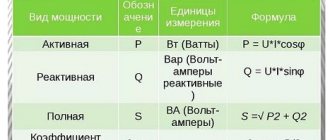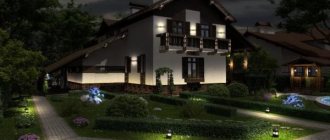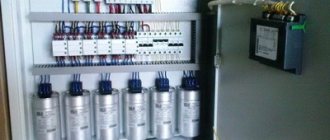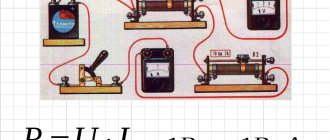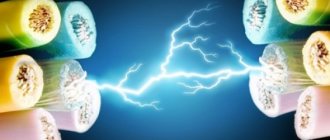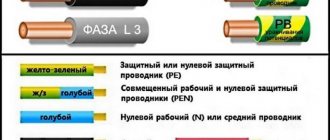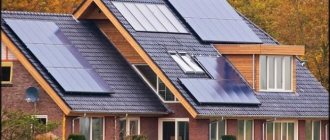What is specific installed capacity?
According to GOST R 19431-84
,
the installed power of an electrical installation
is the highest active electrical power with which the electrical installation can operate for a long time without overload in accordance with the technical specifications or equipment passport.
In this case - in relation to lighting - this is the total rated power of all lamps that are part of the lighting installation
.
Specific installed power
- according to
SP 52.13330.2016
- is
the installed power of artificial lighting in a room, related to the usable area
. In simple terms, the specific installed power shows how many watts of electrical power will be consumed by the artificial lighting system per 1 square meter of illuminated area. To calculate its value, you need to add up all the rated powers of the lamps installed in the room (these values are always indicated in the device passport) and divide the resulting number by the area of the room.
For outdoor lighting, the concept of relative power density of a utility lighting installation is used. The calculation method in this case is a little more complicated than for premises. Details can be found in Appendix M to SP 52.13330.2016
. Specialized software - DIALux, for example - usually calculates this parameter automatically. The corresponding standard values for lighting streets and roads are given in the corresponding article and will not be considered here.
It is also worth noting that all well-made LED lighting systems fall within the values given here with a margin. At least among all the calculations made by our specialists recently, there was not a single one in which the specific installed power was higher than the maximum permissible value. This is achieved due to high luminous efficiency, which is characteristic to varying degrees of all LED lamps.
The values given in the tables must be calculated taking into account the energy consumption of ballasts and lighting control systems, if any, are used.
Calculation of electric lighting using the specific power method. Continuation
Date: August 9, 2010 |
Category: Articles, Artistic lighting Tags: Lighting, Lighting calculation, Lighting system This material was prepared by specialists.
Do you need electrical installation or electrical measurements? Call us! Beginning of the article “Calculation of electric lighting using the specific power method. Start"
Incandescent lamp voltage. In the tables, the specific power is given for incandescent lamps designed for a voltage of 200 V. When using 127 V incandescent lamps in a lighting installation, it is necessary to multiply the specific power value found in the table by 0.68.
Articles in the series “Methods for calculating electric lighting”:
- Introduction.
- Luminous flux utilization factor method.
- Calculation of electric lighting using the specific power method. Start.
- Calculation of electric lighting using the specific power method. Continuation
Lamp efficiency. In all tables, power density values are given for lamps whose efficiency is conventionally 100%. Thus, in order to find out the real value of Pud for the luminaires you have chosen, you need to divide the table value of the specific power by their efficiency, presented in fractions of a unit.
For example, if the efficiency of the lamp is 60%, and the tabulated specific power is 2.9 W/m², then you can determine the real Pud by making the following calculation: 2.9 / 0.6 = 4.83 W/m² As can be seen from the above example, The lower the efficiency of the lamp, the greater the specific power that will be needed to achieve the required illumination.
Luminous flux utilization factor. To determine Pud, it is enough to perform a simplified calculation of the utilization factor that does not take into account the shape of the illuminated room:
Ƞ = 0.48√S / hр (at A/B ≤ 3); Where S is the area of the room; hр is the height of the lamp suspension above the working surface.
Unevenness coefficient z. With general lighting, different areas of the working surface produce different illumination. This phenomenon is taken into account at the design stage due to the unevenness coefficient (Eср/Emin). Typically, if the ratio of the distance between the lamps to the height of their suspension (L/hp) is within the normal range, the value of the z coefficient is taken equal to 1.1 for fluorescent lamps and 1.15 for gas-discharge lamps and incandescent lamps.
The area of the illuminated room S is also important when determining the specific power of the lighting installation according to the tables.
Now that all the quantities that may be needed to determine Pud in the tables have been described, let’s consider the entire sequence of calculation using the specific power method:
1) Selecting the optimal number of lamps (see “Designing the location of lighting fixtures”). 2) Determination of standardized illumination based on the category of visual work (see “Choice of standardized illumination”). 3) Finding the specific power using the corresponding table. 4) Calculation of lamp power Pl and selection from the manufacturer’s catalog of the nearest standard one. 5) If installing lamps of the calculated power is not possible, you should perform the calculation again, adjusting the total number of lamps. To reduce the calculated power of one lamp, it is necessary to increase the number of lamps. And vice versa, if you need to increase the power of the lamps, then the number of lamps must be reduced.
The use of the specific power method is allowed for designing general uniform illumination of almost any objects. However, do not forget that this technique is not suitable for calculating the lighting of such rooms as wardrobes and bathrooms, since they are considered localized. Also, the described method cannot be used in rooms with large shadows.
Specific power of general uniform lighting by lamps with 60 W LN
Specific power of general uniform lighting by lamps with LN power of 100-200 W
Specific power of general uniform lighting by lamps with 300 W LN
Specific power of general uniform lighting by lamps with 500 W LN
Specific power of general uniform lighting by lamps with 1000 W LN
Specific power of general uniform lighting by lamps with LL type LB40
Specific power of general uniform lighting by luminaires with DRL type lamps
Specific power of general uniform lighting by luminaires with DRI type lamps
Specific power of general uniform lighting by lamps with HPS lamps
Articles in the series “Methods for calculating electric lighting”:
- Introduction.
- Luminous flux utilization factor method.
- Calculation of electric lighting using the specific power method. Start.
- Calculation of electric lighting using the specific power method. Continuation
Other and useful information
Other and useful information
Values for industrial premises
Maximum permissible specific installed power of artificial lighting in industrial premises
| Illumination on the working surface, lux | Room index | Maximum permissible specific installed power, W/m² |
| 750 | 0,6 | 30 |
| 0,8 | 26 | |
| 1,25 | 19 | |
| 2 or more | 15 | |
| 500 | 0,6 | 20 |
| 0,8 | 17 | |
| 1,25 | 12 | |
| 2 or more | 10 | |
| 400 | 0,6 | 15 |
| 0,8 | 13 | |
| 1,25 | 10 | |
| 2 or more | 8 | |
| 300 | 0,6 | 12 |
| 0,8 | 10 | |
| 1,25 | 8 | |
| 2 or more | 6 | |
| 200 | 0,6 — 1,25 | 9 |
| 1,25 — 3,0 | 6 | |
| More than 3 | 5 | |
| 150 | 0,6 — 1,25 | 7 |
| 1,25 — 3,0 | 5 | |
| More than 3 | 4 | |
| 100 | 0,6 — 1,25 | 5 |
| 1,25 — 3,0 | 3 | |
| More than 3 | 2,5 |
Values for public buildings
Maximum permissible specific installed power of artificial lighting in public buildings
| Illumination on the working surface, lux | Room index | Maximum permissible specific installed power, W/m² |
| 500 | 0,6 | 23 |
| 0,8 | 20 | |
| 1,25 | 18 | |
| 2 or more | 15 | |
| 400 | 0,6 | 20 |
| 0,8 | 16 | |
| 1,25 | 14 | |
| 2 or more | 12 | |
| 300 | 0,6 | 18 |
| 0,8 | 14 | |
| 1,25 | 12 | |
| 2 or more | 10 | |
| 200 | 0,6 — 1,25 | 14 |
| 1,25 — 3,0 | 8 | |
| More than 3 | 6 | |
| 150 | 0,6 — 1,25 | 10 |
| 1,25 — 3,0 | 8 | |
| More than 3 | 7 | |
| 100 | 0,6 — 1,25 | 5 |
| 1,25 — 3,0 | 3,5 | |
| More than 3 | 3 |
Minimum recommended values of luminous efficiency of devices
The concept of specific installed power is closely related to the concept of luminous efficiency
lighting fixtures.
If a lamp has a low luminous efficiency, a lighting installation designed on its basis may go beyond the regulated specific installed powers. Therefore, here we offer another table for your reference, which shows the minimum recommended values of luminous efficiency of devices used in modern lighting systems. Recommended luminous output of devices depending on their color rendering index
| Source type | Luminous output of lighting devices, lm/W, no less, with minimum permissible color rendering indices Ra | |||
| ≥80 | ≥60 | ≥40 | ≥20 | |
| Lighting devices for general indoor lighting | ||||
| Lighting devices with LED light sources and LED modules | 90 | 100 | — | — |
| Lighting devices with fluorescent light sources | 50 | 40 | — | — |
| Lighting devices with metal halide light sources | 55 | 50 | — | — |
| Lighting fixtures with high pressure sodium lamps | — | 50 | 60 | — |
| Lighting devices for illuminating work areas outside buildings | ||||
| Lighting devices with LED light sources and LED modules | 90 | 100 | — | — |
| Lighting devices with metal halide light sources | — | — | 50 | 50 |
| Lighting fixtures with high pressure sodium lamps | — | — | 50 | 50 |
| Lighting devices with fluorescent light sources | 40 | 50 | — | — |
| Lighting devices for external utilitarian lighting of residential areas | ||||
| Lighting fixtures with LED lamps and modules | 90 | 100 | — | — |
| Lighting devices with metal halide light sources | — | — | 50 | 50 |
| Lighting fixtures with high pressure sodium lamps | — | — | 50 | 50 |
Conclusion
Of course, such complex methodologies are completely unnecessary if you are simply creating seedling lighting at home. For this and similar cases, it is enough to apply the standardized minimum illumination indicator, multiplying it by the area of the room.
And based on the obtained value, select the number and power of lamps. But if we talk about industrial scale, then it is impossible to do without careful calculations. And it is better not to engage in amateur activities in this matter, but to trust a professional design bureau.
